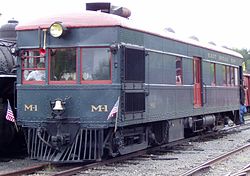| "Doodlebug" | |
|---|---|
 East Broad Top No. M1, a narrow gauge gas-electric doodlebug that was constructed by EBT from a Brill manufactured kit | |
| Manufacturer | Various, including EMC/Pullman, Brill/Mack, Edwards Rail Car Company, McKeen Motor Car Company, Rio Grande Southern Railroad |
| Specifications | |
| Car body construction | Coach/baggage combine |
| Prime mover(s) | Various (gasoline, diesel) |
| Transmission | Various (mechanical, electric, hydraulic) |
| AAR wheel arrangement | Usually B-2 |
| Track gauge | 4 ft 8+1⁄2 in (1,435 mm) and 3 ft (914 mm) |
Doodlebug or hoodlebug is a nickname in the United States for a type of self-propelled railcar most commonly configured to carry both passengers and freight, often dedicated baggage, mail or express, as in a combine.[1] The term has been used interchangeably with jitney.[2][3] The name is said to have derived from the insect-like appearance of the units, as well as the slow speeds at which they would doddle or "doodle" down the tracks.[4] Early models were usually powered by a gasoline engine, with either a mechanical drive train or a generator providing electricity to traction motors ("gas-electrics"). In later years, it was common for doodlebugs to be repowered with a diesel engine.
Doodlebugs sometimes pulled an unpowered trailer car, but were more often used singly. They were popular with some railroads during the first part of the 20th century to provide passenger and mail service on lightly used branch lines at less expense than with a train consisting of a locomotive and coaches with larger crew. Several railroads, mostly small regional and local networks, provided their main passenger services through doodlebugs in a cost-cutting effort.
- ^ American Rails: Doodlebugs
- ^ "Kansas Farm Bureau: The Voice of Agriculture". www.kfb.org. September 12, 2018.
- ^ "Remembering the Jitney". sites.rootsweb.com. April 2000.
- ^ "Doodlebugging on the Frisco, Part I." (PDF). All Aboard, The Frisco Railroad Museum, March, 1988 (accessed on CondrenRails.com). Retrieved October 10, 2020.